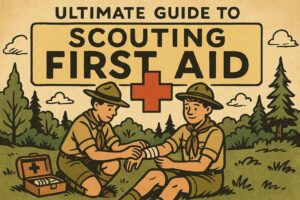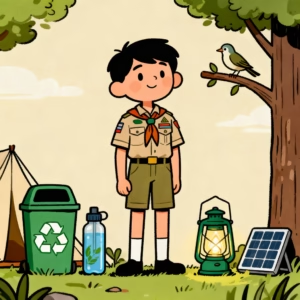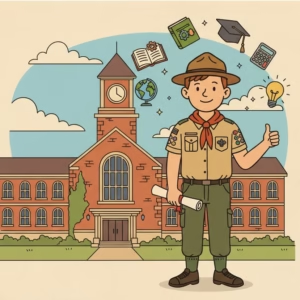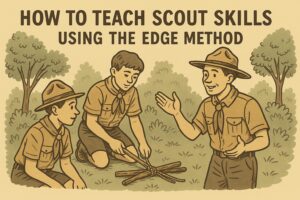First aid is a critical component of the Scouting experience, equipping Scouts with the skills needed to care for themselves and others in times of emergency. Whether it’s treating a minor cut on a hike or providing lifesaving care in a major crisis, first aid knowledge is required at every step of a Scout’s journey.
In this guide, we will explore the core first aid topics that Scouts must master, organized by the types of injuries and conditions they might encounter.
If you’re looking to master first-aid, check out my guide on the first aid merit badge. Taking this badge will give you the tools to handle almost any situation you’ll find in Scouting.
***DISCLAIMER – While this article tries to pull from reliable sources, I am not a medical professional. First aid skills are extremely important and using improper first aid techniques could cost someone their life. Make sure to discuss your first aid skills with a trained counselor or medical professional to ensure your and others’ safety.***
1. Cuts, Scrapes, and Wounds
One of the most common injuries in outdoor activities is a cut or scrape. Scouts need to know how to prevent infection, control bleeding, and care for different types of wounds.
Skills Required:
- Cleaning and Dressing Wounds: Scouts learn how to clean a wound with soap and water or antiseptic and then apply a clean dressing or bandage to prevent infection.
- Controlling Bleeding: Applying pressure to a wound to stop bleeding is essential, and in more serious cases, using a tourniquet (with caution and proper knowledge) may be necessary.
- Treating Blisters: Properly cleaning, protecting, and preventing blisters from worsening during hikes or outdoor activities.
2. Burns
Whether it’s from a campfire, stove, or sun exposure, burns are another frequent concern in the outdoors. Knowing the severity of a burn and how to treat it is crucial.
Skills Required:
- First-Degree Burns (Mild): These can be treated by cooling the burn under cool water for 10-15 minutes, then applying a sterile dressing.
- Second-Degree Burns (Moderate): For more serious burns that blister, Scouts need to apply cool water and cover the area with a loose, sterile bandage without popping the blisters.
- Third-Degree Burns (Severe): Immediate emergency assistance is necessary. Scouts should ensure the person is out of harm’s way and treat for shock while waiting for medical professionals.
3. Fractures, Sprains, and Dislocations
Outdoor adventures can lead to falls and accidents, resulting in broken bones, sprains, or dislocated joints. Quick and careful action is necessary to stabilize the injury.
Skills Required:
- Fracture Management: Using splints made from sticks or other rigid objects to immobilize a broken bone and prevent further injury.
- Treating Sprains and Strains: Scouts use the R.I.C.E. method: Rest, Ice, Compression, and Elevation to reduce swelling and support recovery.
- Handling Dislocations: Immobilizing the affected joint and getting medical attention is key. Scouts are taught not to attempt to pop a joint back in place.
4. Choking and Respiratory Emergencies
Knowing how to assist someone who is choking or struggling to breathe is a vital lifesaving skill.
Skills Required:
- Heimlich Maneuver (Abdominal Thrusts): Scouts learn how to deliver abdominal thrusts to a choking person to dislodge the obstruction.
- Rescue Breathing: Providing breaths to someone who has stopped breathing, while awaiting more advanced medical help.
- CPR: Cardiopulmonary resuscitation (CPR) is critical for responding to cardiac arrest. Scouts must learn the proper technique for chest compressions and rescue breaths.
5. Water-Related First Aid
Water-based activities like swimming and boating are fun but come with their own unique set of dangers. Being prepared for these situations is crucial for Scouts.
Skills Required:
- Drowning Response: Scouts learn how to safely approach a drowning victim, perform water rescues, and administer rescue breathing or CPR once the person is on dry land.
- Hypothermia: For cold water exposure, Scouts must recognize the symptoms of hypothermia (shivering, confusion, slurred speech) and rewarm the person slowly with dry clothing and blankets.
- Heatstroke: Overexposure to heat during activities in and around water can lead to heat exhaustion or heatstroke. First aid includes moving the person to a cooler area, hydrating them, and cooling their body with water.
6. Shock
Shock can result from severe injuries, burns, or blood loss. Recognizing and treating shock is essential in any emergency.
Skills Required:
- Symptoms of Shock: Recognizing signs such as pale, clammy skin, rapid pulse, and confusion.
- Treatment: Scouts are trained to lay the person down, elevate their legs, and cover them with a blanket to maintain body heat. Reassuring the victim and calling for medical help are critical steps.
7. Poisonous Plants and Insect Bites
Scouts often spend time in nature, where poisonous plants and insects are prevalent. Knowing how to avoid and treat exposure is key.
Skills Required:
- Identifying Poison Ivy, Oak, and Sumac: Scouts learn to recognize these plants and avoid contact. If exposure occurs, washing the area with soap and water can help prevent a rash.
- Treating Insect Bites and Stings: For minor bites, Scouts can clean the area and apply ice to reduce swelling. For more serious reactions, like bee stings that cause anaphylaxis, Scouts must know how to use an epinephrine auto-injector and seek emergency help.
8. Heat- and Cold-Related Emergencies
Outdoor adventures expose Scouts to various weather conditions, and being prepared for both heat and cold is vital.
Skills Required:
- Treating Heat Exhaustion and Heatstroke: Moving the person to a cool area, hydrating them, and applying cool cloths to the body. In severe cases, emergency medical help is needed.
- Treating Frostbite and Hypothermia: For frostbite, gently warming the affected area and covering it is key. For hypothermia, slow rewarming and insulation from the cold are essential to prevent further heat loss.
9. Building a First Aid Kit
Every Scout should know how to build and maintain a personal and troop first aid kit. These kits should include essentials like bandages, antiseptic wipes, tweezers, and gloves. Depending on the environment and activity, Scouts may also need items like tourniquets, blister treatment supplies, and burn ointments.
10. Online Resources for First Aid in Scouting
To continue developing your first aid knowledge, there are numerous online resources that provide detailed guides, videos, and interactive tools. These resources are invaluable for Scouts who want to review first aid skills or stay up to date with the latest techniques. Here are some top resources to help you master first aid:
1. Boy Scouts of America (BSA) Official Website
The BSA website offers a variety of resources including merit badge worksheets, rank requirement guides, and first aid training modules.
2. American Red Cross
The Red Cross provides comprehensive first aid training, including online classes and certifications, which are highly recommended for Scouts wanting to deepen their understanding.
- American Red Cross First Aid Training: Interactive online first aid, CPR, and AED training.
3. Mayo Clinic First Aid Guide
Mayo Clinic offers easy-to-understand first aid tips and advice on a wide range of topics. This is an excellent resource for both common and serious injuries.
- Mayo Clinic First Aid Tips: Access to medical guides for common emergencies like burns, cuts, and fractures.
4. Centers for Disease Control and Prevention (CDC)
The CDC provides safety tips and first aid guides tailored to specific situations like outdoor safety, preventing heat-related illnesses, and dealing with insect bites.
- CDC Emergency Preparedness and First Aid: A guide to creating emergency kits and responding to various emergencies.
5. First Aid App (American Red Cross)
The American Red Cross offers a mobile app that provides first aid tips and step-by-step instructions for a wide range of emergencies, even without an internet connection.
- First Aid App: Download this free app to have first aid instructions always on hand during Scouting activities.
6. YouTube Channels
Many reputable channels offer visual step-by-step demonstrations of first aid techniques. Watching these can help reinforce your practical skills.
- Red Cross YouTube Channel: Offers a wide range of first aid tutorials.
7. National Institutes of Health (NIH) MedlinePlus
MedlinePlus is a trusted resource for health information, and their first aid section covers everything from minor cuts to more serious injuries.
- MedlinePlus First Aid: An in-depth library of first aid advice and emergency care techniques.
8. Wilderness Medical Society
For Scouts involved in outdoor and wilderness activities, the Wilderness Medical Society offers specialized resources on wilderness first aid.
- Wilderness Medicine Resources: Articles and guides on wilderness first aid and outdoor safety.
Conclusion: First Aid—A Core Scouting Skill
First aid is an essential part of the Scouting experience, from Tenderfoot to Eagle Scout. Mastering these skills not only prepares Scouts to care for themselves and others in times of need, but also builds confidence, responsibility, and leadership. The ability to stay calm, act quickly, and make the right decisions in an emergency can make all the difference.
Every hike, campout, and adventure is an opportunity to practice these lifesaving skills—and to embody the Scout motto: Be Prepared.





